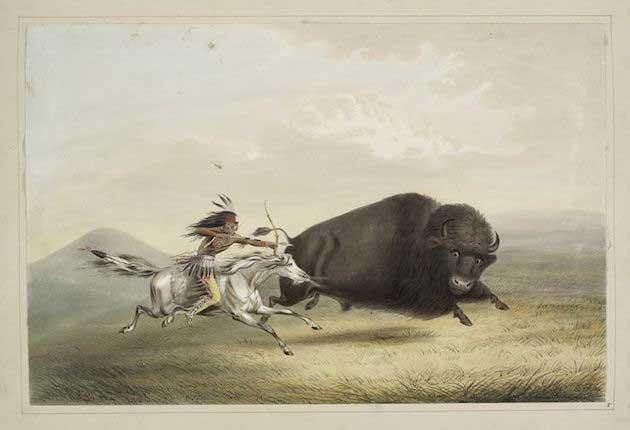- Horses were introduced to the New World by Spanish conquistadors, quickly finding favor with native hunters.
- Bull bison can reach 11 feet long, stand six feet at the shoulder, and weigh more than a ton.
- The Blackfoot, Cheyenne, Lakota, Kiowa, and twelve other Plains Indian tribes were horse-driven nomads that followed the “buffalo” for their livelihoods.
- Bison hunting was incredibly dangerous. Hunts were often more lethal than tribal wars.
- Native hunters would dress in animal skins to cut groups off from the rest of the herd.
- Native hunters would cut off 50 to 60 animals from the herds of more than a million, firing arrows from horseback to secure their quarries.
- In the winter hunters would follow the bison on snowshoes, driving them into drifts where they became stuck and were easier to approach.
- Bringing down a bison required numerous arrows. Few, if any, one-shot kills took place on the open prairies.
- Native Americans used every piece of a taken animal. Even the surplus robes and meat were traded to other tribes, ensuring nothing went to waste.
George Catlin was fascinated with the American West — its peoples and its wildlife — from an early age. He was born in 1796 to maternal stories of Indian tribes and frontier life, began painting the subjects in his adulthood, and, when a friend returned from the Lewis and Clark expedition with tales of the dwindling native populations he had seen, made up his mind to go chronicle the Native Americans and great herds of “buffalo” before they were gone forever.
He accompanied William Clark on a diplomatic mission up the Mighty Mississipp’ in 1830. St. Louis subsequently became Catlin’s jumping-off point for five trips between 1830 and ’36; in those six adventurous years he visited 50 tribes.
What many of them shared was their utter reliance on and reverence for the American bison. Million-animal herds still roamed the open grasslands with Indians in tow. Horses enabled hunters to travel close behind the herds as well as hunt alongside and amongst them. Catlin took it all in, then spent the rest of his life lovingly putting it down in paint. These paintings were part of his effort to celebrate the first Americans and their ways, and are now part of the New York Public Library’s digital collection.










